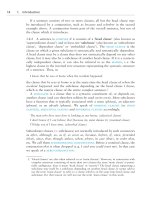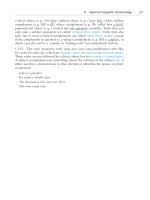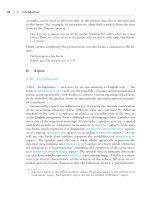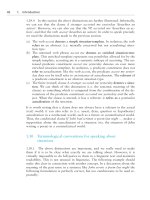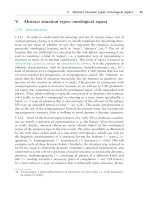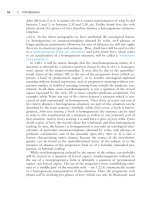The grammar of the english verb phrase part 8 doc
Bạn đang xem bản rút gọn của tài liệu. Xem và tải ngay bản đầy đủ của tài liệu tại đây (75.05 KB, 7 trang )
42 1. Introduction
1.29.4 In this section the above distinctions are further illustrated. Informally,
we can say that the clause A stranger accosted me yesterday ‘describes an
action’. However, we can also say that the VP accosted me ‘describes an ac-
tion’, and that the verb accost ‘describes an action’. In order to speak precisely
we need the distinctions made in the previous section:
(a) The verb accost denotes a simple situation-template. In isolation, the verb
refers to an abstract (i. e. mentally conceived but not actualizing) situa-
tion type.
(b) The untensed verb phrase accost me denotes an enriched situation-tem-
plate. This enriched template represents one possibility allowed for by the
simple template: accosting me is a semantic subtype of accosting. The un-
tensed predicate constituent accost me yesterday denotes an even more
enriched situation-template. In isolation, a predicate constituent does not
refer to actualization: like the verb accost, the predicate accost me yester-
day does not by itself refer to an instance of actualization. The referent of
a predicate constituent is an abstract situation type.
(c) The finite (tensed) clause A stranger accosted me yesterday denotes a situa-
tion. We can think of this denotation (i. e. the semantic meaning of the
clause) as something which is computed from the combination of the de-
notations of the predicate constituent accosted me yesterday and the sub-
ject. When the clause is uttered, it has a referent: it refers to a particular
actualization of the situation.
It is worth noting that a clause does not always have a referent in the actual
(real) world: it can also refer to (i. e. assert, deny, question or hypothesize)
actualization in a nonfactual world, such as a future or counterfactual world.
Thus, the conditional clause If John had written a poem last night … makes a
supposition about the actualization of a situation (viz. the situation of John
writing a poem) in a counterfactual world.
1.30 Terminological conventions for speaking about
situations
1.30.1 The above distinctions are important, and we really need to make
them if it is to be clear what exactly we are talking about. However, it is
virtually impossible to do full justice to them in a linguistic text and maintain
readability. This is not unusual in linguistics. The following example should
make this clear in connection with another concept. In a discussion about the
meaning of the past tense in a sentence like John wrote a poem last night the
following formulation is perfectly correct, but too cumbersome to be used re-
peatedly:
IV. The precise meanings and uses of ‘situation’ and ‘actualization’ 43
The past tense locates the time of actualization of the situation referred to
at a specific past time (specified by last night.)
This is normally simplified to one of the following:
The past tense locates the time of the situation referred to at a specific past
time (specified by last night.)
The past tense locates the situation referred to at a specific past time (speci-
fied by last night.)
In a similar way, some of the terms introduced in this chapter will often be
used in a ‘sloppy’ way in this work. However, this sloppy use is by no means
arbitrary. It observes the following conventions:
(a) Using the term verb phrase (VP)
Strictly speaking, a verb phrase is a phrase (group of words) with a verb as
head. Thus, the clause John presumably left the house contains the VP left
the house. (Together with the adverb presumably, the VP forms the ‘predicate
constituent’, i. e. that part of the clause that is not the subject Ϫ see section
1.7.) However, in John presumably left, the VP contains no lexical material
besides the verb left. This form does not consist of a group of words (ϭ a
phrase), but for simplicity it is normally treated as ‘the VP of the sentence’.
Similarly, in John left, the predicate constituent only consists of left. In this
case the verb form left constitutes not only the VP but also the predicate con-
stituent of the sentence.
When using the term ‘verb phrase’ we will not normally need to distinguish
between one-word VPs and multi-word VPs. So we will generally use the term
verb phrase to cover both possibilities.
(b) Using the term situation-template
In a similar way, there are not many contexts in which it is necessary to
distinguish carefully between a ‘simple situation-template’ (expressed by a
verb) and an ‘enriched situation-template’ (expressed by a VP or a longer predi-
cate constituent). So we will use ‘situation-template’ to cover the two possibil-
ities.
(c) Using the terms situation and refer to
Strictly speaking, a verb phrase denotes a situation-template and (if uttered)
refers to an abstract type of situation, whereas a finite clause denotes a situa-
tion and (if uttered) refers to the actualization of that situation. However, for
convenience we will generally use the terms ‘situation’ and ‘refer to’ in a simpli-
fied sense. Thus, we will often use ‘situation’ as an abbreviation of ‘actualiza-
tion of the situation denoted’. In this sense we can speak of ‘the situation
referred to by a clause’. (As noted in 1.29.2, the referent of a finite clause is
44 1. Introduction
not really a situation but one or more actualizations of a situation. However,
it is seldom necessary to make this distinction explicitly.)
In addition, there will be many contexts in which we will use ‘situation’ in
the sense of ‘situation-template’. It was argued in 1.29.1 above that verb
phrases denote situation-templates rather than situations: whereas John walked
home refers to (the actualization of) a situation, walk denotes a situation-
template: it is the simple template underlying more enriched situation-templates
like walk home, walk home slowly, walk with a limp, etc. However, in what
follows we will sometimes simplify this (as long as no misunderstanding is
possible) and speak of the VP (or verb) denoting situations or even referring
to situations. This sloppy use of ‘situation’ and ‘referring’ will also be made in
connection with nonfinite clauses that do not refer to actualization but denote
a kind of situation, such as the subject clauses of Betraying one’s friends is
unforgivable and For John to betray his friends is unthinkable. Strictly speak-
ing, such nonfinite clauses denote an enriched situation-template and refer to
a situation type rather than to the concrete actualization of a situation. How-
ever, it is handy if we can speak of ‘the situation referred to by For John to
betray his friends’.
In sum, while the finer distinctions reflected by the more complex terminol-
ogy are essential, we will use simplified formulations when it is not really
necessary to use the more correct but more complex and cumbersome formula-
tions.
1.30.2 In conclusion, verb phrases can only denote rather abstract schemata
for situations, which we call ‘situation-templates’, and, if uttered, refer to ab-
stract situation types, whereas clauses denote situations and, when they are
finite and used in an utterance, refer to particular actualizations of situations.
That is, walk and walk to the church each denote a schematic sort of situation,
which has particular semantic characteristics so that it can be classified, for
example, in Vendlerian terms (see 1.43 below) as an ‘activity’ in the first case
and an ‘accomplishment’ in the second case. But both lack some information
(such as a subject and a tense) necessary to denote a situation proper, and
consequently neither can be used to refer to any particular instance of actual-
ization, whereas John walked to the church, having a location in time and a
subject, denotes a complete situation and can be used to refer to an actualizing
situation. However, we will follow common practice in talking of ‘situations’
where ‘situation-templates’ or ‘situation types’ would be more appropriate, and
‘reference’ where ‘denotation’ would be more correct, so that we will talk of
both clauses and verb phrases as ‘referring to situations’. For example, we will
say that walk to the church ‘refers to a telic situation’, even though VPs cannot
denote situations, still less refer to actualizations of situations.
IV. The precise meanings and uses of ‘situation’ and ‘actualization’ 45
1.31 Terminology used to refer to situation types and
verb classes
1.31.1 Situations can, for some purposes, be grouped according to the way
in which the situation unfolds in time, its internal constitution Ϫ does it consist
of one unchanging state, for example, or does it consist of various different
phases? Ϫ and certain other criteria that have to do with beginnings, middles
and ends of situations. The point of grouping situations in this way is that this
enables us to make interesting linguistic generalizations, as will become clear
as this and the following chapters proceed. Two common classifications of
sorts of situations (i. e. situation types) will be discussed in detail in 1.42 and
1.43 below. For the moment, we are concerned with the terminology we need
to make the distinctions underlying these classifications.
We often find in the literature such terms as ‘
punctual situation’ to de-
scribe a situation which is perceived as having no duration (i. e. as taking up
just a point in time) Ϫ for example the situation represented by Jill jumped or
Norbert knocked. Similar terms are ‘
static situation’ (which refers to a situa-
tion that is perceived as being a state, such as the situation represented by Jill
was ill) and ‘
durative situation’ (which refers to a situation that is perceived
as having a certain duration, such as the situation represented by Jill walked).
Another grouping is that of ‘
homogeneous situations’, like that referred to by
Jill was in Jutland. This sentence represents a situation which is felt to be
completely uniform, so that any moment of Jill’s being in Jutland is just like
any other moment of her being in Jutland.
Nonhomogeneous situations are,
naturally enough, referred to as ‘
heterogeneous situations’. An example of
such a situation is that represented (ϭ referred to) by Jill planted a juniper
bush, in which we discern various phases rather than an unchanging state.
(Roughly speaking, we expect that Jill will be doing different things at different
moments of planting the bush.)
As well as applying such labels to situations (and to the clauses denoting
them), the literature also applies these labels to the verbs or verb phrases which
typically refer to a particular group of situations. We read of ‘punctual verbs’,
‘durative verbs’, etc., by which is meant ‘verbs that typically refer to punctual
situations’, ‘verbs that typically refer to durative situations’ and so on. How-
ever, the literature is not completely consistent. Thus, next to the somewhat
opaque term ‘punctual verb’, we find the more accurate and transparent term
‘transitional event verb’ (sometimes ‘change of state verb’), used to refer to
verbs which always or typically refer to situations which constitute a transition
from one state into another Ϫ for example, die or burst. In what follows, when
we wish to refer to a category of verbs that are associated with a particular
sort of situation, we will speak of ‘punctual situation verbs’, ‘durative situation
verbs’ and so on, following the pattern of ‘transitional event verb’ (which,
46 1. Introduction
however, we shall adapt to ‘transitional situation verb’, since not all situations
that constitute a transition from one state to another are events, in our
terms).
14
This move is intended to arrive at a more consistent nomenclature,
and to provide a pattern on which new terms that we will need to introduce
can be modelled in such a way that their meaning is as transparent as possible:
the term ‘heterogeneous situation verb’ should, we hope, be transparent in a
way that ‘heterogeneous verb’ might not be. Of course, in some cases, the
meaning of ‘situation’ is contained inside another term, notably in the case of
‘state’, ‘event’, ‘action’ and ‘process’ (see 1.42 below). This means that next to
category names like ‘punctual situation verb’ we will also be using such terms
as ‘state verbs’, ‘event verbs’, and so on.
1.31.2 It should also be borne in mind that when people speak about ‘situa-
tion’ they often mean ‘representation of a situation (by a clause)’. This may
create confusion, because one and the same real-world situation can sometimes
be represented in different ways. Thus, John drank beer and John drank a
glass of beer can both be uttered with reference to the same (actualization
of the) situation, but John drank beer represents the situation as ‘atelic’ and
‘homogeneous’, whereas John drank a glass of beer represents it as ‘telic’ and
‘heterogeneous’.
15
This means that it is not the situations themselves that are
(a)telic or (non)homogeneous, but the situations as they are denoted by clauses.
A similar example is the use of ‘punctual’. Though we normally speak of ‘punc-
tual situations’ (i. e. situations that are perceived as lasting no longer than a
moment), it is sometimes the representation rather than the situation itself that
is punctual. Thus, the same real-world action can be described using yank or
pull. In the former case, a punctual situation verb is used, and the situation is
represented as punctual; in the latter case, a durative situation verb is used,
and the situation is represented as taking place over (perhaps a very short)
time. Thus, if the VP is made progressive (The girl behind her was {yanking /
pulling} her braids), we get a repetitive meaning in the case of yank: the situa-
tion is represented as consisting of several sharp movements; in the case of
pull, the situation representation is vague between repetitive and continuous,
but, because pull represents a situation as nonpunctual, it is at least possible
to get a representation of one continuous movement, an interpretation which
is not possible with yank,e.g.The girl behind her was leaning back as far as
14. For example, according to the terminology introduced in section 1.42.3 below, the verb
stop as used in The man stopped to light a cigarette does not refer to an ‘event’ but to
an ‘action’.
15. As we will see in section 1.39, ‘telic’ means that the situation is represented as tending
towards an inherent point of completion, whereas ‘atelic’ means that it is not. ‘Homo-
geneous’ means that the same linguistic expression can be used to represent the situation
as a whole as well as to represent parts of it. ‘Heterogeneous’ means ‘nonhomogeneous’.
IV. The precise meanings and uses of ‘situation’ and ‘actualization’ 47
she could and {
?
yanking / pulling} her braids in an attempt to drag her out of
the quagmire.
However, it would clearly complicate our terminology too much if it system-
atically reminded the hearer of the fact that we are talking about the represen-
tation of a situation rather than about the situation itself. ‘Punctual situation’
and ‘punctual situation verb’ are terms that are both transparent and not too
complex. Substituting ‘punctual situation-representation’ and ‘punctual situa-
tion-representation verb’ for them would reduce the readability of the text.
(Replacing the simplified term ‘punctual situation verb’ by the quite correct
‘verb denoting a simple template for a punctual situation’ would have an even
worse effect.) We will therefore neglect the distinction between ‘situation’ and
‘situation-representation’ as long as there is no particular reason to pay atten-
tion to it.
1.32 Situation types
1.32.1 As noted in 1.29.1, any verb or verb phrase denotes a situation-tem-
plate. The nature of the template is determined by the lexical contents of the
verb (phrase) in question. For example, know represents the situation referred
to as having the features [ϩ static], [Ϫ agentive], [ϩ homogeneous], [Ϫ transi-
tional], [ϩ durative], [Ϫ telic] and [Ϫ evolving] Ϫ see sections 1.34Ϫ40 be-
low.
16
These various features are inherent in the lexical meaning (lexical se-
mantics) of the verb know and form part of a mode of categorization which in
the linguistic literature is known as ‘Aktionsart’, ‘lexical aspect’, or ‘ontological
aspect’. This category will be examined in detail in sections 1.33Ϫ40. (At this
point we are only concerned with the terminological implications of such dis-
tinctions.)
Because the above features are inherent in the lexical meaning of the verb
know, they are present in any predicate constituent using know as head of its
verb phrase. The features are therefore typical, not only of the simple situation-
template of the verb know but also of all more enriched situation-templates
using this verb (i. e. VPs and more complex predicate constituents). Moreover,
features such as [( static], [( agentive], [( homogeneous], [( transitional],
[( durative], [( telic], etc.
17
can also be applied to what situation-templates
refer to, viz. situation types. In fact, since ‘situation’ is often used sloppily to
16. There is a certain hierarchy in this list of features. For example, [ϩ static] automatically
entails all the other features mentioned. However, this observation is not important at
this point of the discussion.
17. The meaning of the ( sign is not ‘more or less’ but ‘either ϩ or Ϫ’, i. e. the feature may
or may not be present.
48 1. Introduction
talk about an abstract situation type, people often talk of ‘static situations’
rather than ‘static situation-templates’ or ‘static situation types’.
1.32.2 In the linguistic literature the term ‘situation type’ is often used in a
sense different from ‘abstract type of situation’, viz. to refer to types of actualiz-
ing situations as they are denoted by clauses. For example, Lyons’ (1977) cat-
egorization of situation types into states, actions, processes (ϭ developments)
and events Ϫ see 1.42 below Ϫ is often applied to actualizing situations on the
plea that the nature of a category can be determined by any constituent of the
clause, including the subject. Thus, depending on the nature of the subject
referent, which may be [ϩ human] or [Ϫ human], the actualizing situation
referred to by a clause using break is said to be either an ‘action’ (i. e. a dynamic
situation whose actualization is caused by a consciously acting agent, as in
John broke the window) or an ‘event’ (i. e. a dynamic situation which simply
happens, without there being an identifiable agent, as in The key broke in
the lock).
In order to avoid any confusion it would be advisable to apply the label
‘type of situation’ to the referent of a verb, verb phrase or predicate constituent
only. In other words, it would be ideal if ‘type of situation’ were short for
‘abstract type of situation’. The term ‘type of actualizing situation’ could then
be applied to the referent of a full clause. However, this distinction is often
ignored in the literature.
1.32.3 In what follows we will examine the features and typology that can
be discerned within each of these sets of types.



